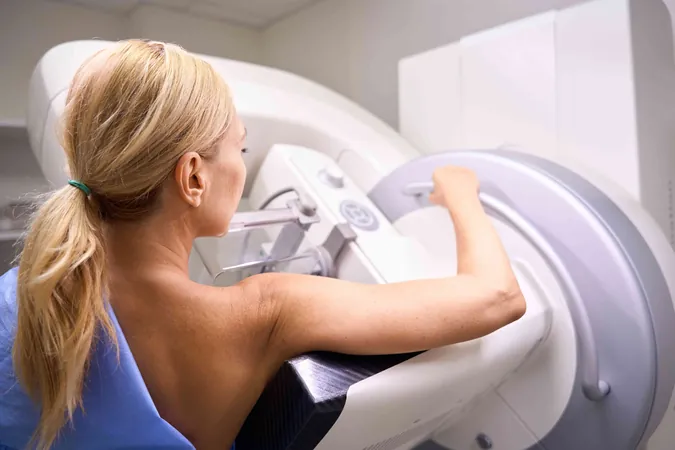
Alarm Bells Ringing: Young Women Face Sharp Rise in Breast Cancer Diagnoses
2024-10-08
Author: Wei
Introduction
A startling new study from the American Cancer Society reveals a troubling trend: breast cancer diagnoses are increasingly common among women under the age of 50. This research, published recently in CA: A Cancer Journal for Clinicians, provides a comprehensive overview of breast cancer incidence and mortality in the U.S. over the past decade.
Overall Trends
While the overall breast cancer death rate has observed a significant decrease of 44% since its peak in 1989, the incidence rates tell a different story. Between 2012 and 2021, diagnoses rose by approximately 1% annually. Alarmingly, the increase was even more pronounced among younger women, with a 1.4% rise in cases for those under 50 compared to just 0.7% for those over 50. The steepest increases were seen in women in their twenties, whose diagnosis rates climbed by a staggering 2.2%.
Among different demographics, Asian American and Pacific Islander women are experiencing the fastest growth in breast cancer rates, with increases exceeding 2% within these communities. This data underscores the critical need for heightened awareness about breast cancer risks among younger women, as noted by experts in the field.
Dr. Tiffany Onger, a noted medical oncologist, explained, "This rise in early-onset cancers mirrors our clinical observations. We’ve also seen rising cases in colon cancer prompting changes in screening guidelines, and breast cancer is now following suit."
Deep Dive into Rising Rates
The study highlights that by their 50th birthday, around 1 in 50 women in the U.S. will be diagnosed with invasive breast cancer. The rise in cancer cases among younger women is attributed to several factors, including increasing obesity rates, declining fertility, and a more sedentary lifestyle—situations exacerbated by widespread physical inactivity (which contributes to an estimated 7% of breast cancer cases).
Moreover, alcohol consumption, especially heavy drinking among women in their thirties and forties, now plays a role in a concerning 16% of breast cancer cases.
The research also highlights significant racial and ethnic disparities. Between 2017 and 2021, women of color—Black, Hispanic, Asian American, and Pacific Islander—were diagnosed with breast cancer at higher rates than their white counterparts. Among women under 50, Black women were found to have the highest mortality rates from the disease, a stark 38% more likely to die from breast cancer despite a 5% lower overall incidence when compared to white women.
"Native American women face a particularly grim reality; they have seen no improvement in mortality rates for decades and are 6% more likely to die from breast cancer compared to white women," Giaquinto noted, calling attention to the urgent need for improved access to treatment and screening.
Empowering Young Women for Early Detection
In the U.S., medical guidelines advocate for annual mammograms starting at age 40 for women at average risk. However, the research strongly emphasizes early education about breast cancer for women even before they are eligible for screening.
Family history can play a crucial role in assessing breast cancer risk. Dr. Onger emphasizes the importance of discussing any family history of the disease with a healthcare provider, who may recommend earlier screening for those at heightened risk.
Additionally, knowledge about breast health is crucial. Women of all ages should become familiar with how their breasts typically look and feel. “Any persistent changes lasting more than two weeks should be evaluated by a healthcare provider,” Onger advises.
Key Symptoms to Watch For
Key symptoms to watch for include: - A painless lump in the breast or underarm - Breast pain - Heaviness in the breast - Swelling or thickening - Dimpling or redness of the breast skin - Changes in the nipple, including discharge
By being attentive to these symptoms, women can prompt earlier evaluations and potentially improve outcomes. "Cancer increasingly affects younger people," Giaquinto warns. Awareness and timely action are crucial in the fight against this growing health crisis facing women today.




 Brasil (PT)
Brasil (PT)
 Canada (EN)
Canada (EN)
 Chile (ES)
Chile (ES)
 España (ES)
España (ES)
 France (FR)
France (FR)
 Hong Kong (EN)
Hong Kong (EN)
 Italia (IT)
Italia (IT)
 日本 (JA)
日本 (JA)
 Magyarország (HU)
Magyarország (HU)
 Norge (NO)
Norge (NO)
 Polska (PL)
Polska (PL)
 Schweiz (DE)
Schweiz (DE)
 Singapore (EN)
Singapore (EN)
 Sverige (SV)
Sverige (SV)
 Suomi (FI)
Suomi (FI)
 Türkiye (TR)
Türkiye (TR)